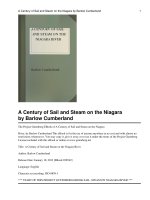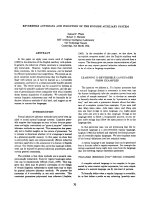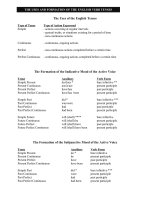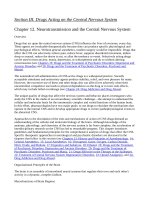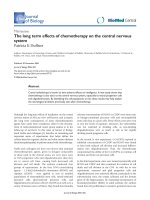Cases and Materials on the English Legal System doc
Bạn đang xem bản rút gọn của tài liệu. Xem và tải ngay bản đầy đủ của tài liệu tại đây (4.38 MB, 925 trang )
This page intentionally left blank
Cases and Materials on the English Legal System
Combining materials from a wide variety of sources with Michael Zander’s
authoritative commentary, this book provides the tools with which an observer
of the English legal system can discover how it functions, the problems it faces
and the current reforms proposed.
The organisation of the trial courts, the problems of civil litigation, the
balance between the citizen and state in criminal cases, the trial and appeal
process including the basic rules of evidence, the jury, the cost and funding of
legal proceedings and the present state of the legal profession are explored by
the author drawing on a wealth of cases, reports of official and other bodies,
parliamentary debates and the fruits of empirical research.
The tenth edition has been extensively revised with a mass of new material.
Major developments since the ninth edition include: the Constitutional Reform
Act 2005, new research on the effect of the Woolf reforms, the Criminal
Procedure Rules 2005, significant changes to PACE and revised PACE Codes
(January 2006), the Serious Organised Crime and Police Act 2005, the
Prevention of Terrorism Act 2005 and the Terrorism Act 2006, new arrange-
ments for the charging of suspects, the Disclosure Protocol 2006, the suspect’s
right to ask for an indication of sentence, general eligibility for jury service, the
introduction of fixed fees for some categories of litigation, Lord Carter’s Review
of the procurement of legal aid (July 2006) and the 2006 consultation paper
Legal Aid: A Sustainable Future?, the new system for appointing QCs, the
Clementi Review of regulation of legal services (2004) and the Legal Services
Bill (2006). There have also been a large number of new cases.
Michael Zander QC is Emeritus Professor of Law at the London School of
Economics and Political Science. He was a member of the Runciman Royal
Commission on Criminal Justice which reported in 1993. An established author
and researcher, he is also a regular journalist, a frequent broadcaster on radio
and television, and is recognised as the leading authority on the workings of the
legal system.
Editors William Twining (University College London) and
Christopher McCrudden (Lincoln College, Oxford)
Since 1970 the Law in Context series has been in the forefront of the movement to
broaden the study of law. It has been a vehicle for the publication of innovative scholarly
books that treat law and legal phenomena critically in their social, politial and economic
contexts from a variety of perspectives. The series particularly aims to publish scholarly
legal writing that brings fresh perspectives to bear on new and existing areas of law
taught in universities. A contextual approach involves treating legal subjects broadly,
using materials from other social sciences, and from any other discipline that helps to
explain the operation in practice of the subject under discussion. It is hoped that this ori-
entation is at once more stimulating and more realistic than the bare exposition of legal
rules. The series includes original books that have a different emphasis from traditional
legal textbooks, while maintaining the same high standards of scholarship. They are
written primarily for undergraduate and graduate students of law and of other disci-
plines, but most also appeal to a wider readership. In the past, most books in the series
have focused on English law, but recent publications include books on European law,
globalisation, transnational legal processes, and comparative law.
Books in the Series
Anderson, Schum & Twining: Analysis of Evidence
Ashworth: Sentencing and Criminal Justice
Barton & Douglas: Law and Parenthood
Bell: French Legal Cultures
Bercusson: European Labour Law
Birkinshaw: European Public Law
Birkinshaw: Freedom of Information: The Law, the Practice and the Ideal
Cane: Atiyah’s Accidents, Compensation and the Law
Clarke & Kohler: Property Law: Commentary and Materials
Collins: The Law of Contract
Davies: Perspectives on Labour Law
Dembour: Who Believes in Human Rights?: The European Convention in Question
de Sousa Santos: Toward a New Legal Common Sense
Diduck: Law’s Families
Elworthy & Holder: Environmental Protection: Text and Materials
Fortin: Children’s Rights and the Developing Law
Glover-Thomas: Reconstructing Mental Health Law and Policy
Goldman: Globalisation and the Western Legal Tradition: Recurring Patterns of Law
and Authority
Gobert & Punch: Rethinking Corporate Crime
Harlow & Rawlings: Law and Administration: Text and Materials
Harris: An Introduction to Law
Harris, Campbell & Halson: Remedies in Contract and Tort
Harvey: Seeking Asylum in the UK: Problems and Prospects
Hervey & McHale: Health Law and the European Union
Holder & Lee: Environmental Protection, Law and Policy: Text and Materials
Lacey & Wells: Reconstructing Criminal Law
Lewis: Choice and the Legal Order: Rising above Politics
Likosky: Transnational Legal Processes
Maughan & Webb: Lawyering Skills and the Legal Process
McGlynn: Families and the European Union: Law, Politics and Pluralism
Moffat: Tr usts Law: Text and Materials
Monti: EC Competition Law
Morgan & Yeung: An Introduction to Law and Regulation
Norrie: Crime, Reason and History
O’Dair: Legal Ethics
Oliver: Common Values and the Public–Private Divide
Oliver & Drewry: The Law and Parliament
Picciotto: International Business Taxation
Reed: Internet Law: Text and Materials
Richardson: Law, Process and Custody
Roberts & Palmer: Dispute Processes: ADR and the Primary Forms of Decision-Making
Scott & Black: Cranston’s Consumers and the Law
Seneviratne: Ombudsmen: Public Services and Administrative Justice
Stapleton: Product Liability
Tur pin and Tomkins: British Government and the Constitution: Text and Materials
Tw ining: Globalisation and Legal Theory
Tw ining: Rethinking Evidence
Tw ining & Miers: How to Do Things with Rules
Ward: A Critical Introduction to European Law
Ward: Shakespeare and Legal Imagination
Zander: Cases and Materials on the English Legal System
Zander: The Law-Making Process
Cases and Materials on the
English Legal System
Tenth Edition
MICHAEL ZANDER QC FBA
Emeritus Professor of Law, London School of Economics and Political Science
CAMBRIDGE UNIVERSITY PRESS
Cambridge, New York, Melbourne, Madrid, Cape Town, Singapore, São Paulo
Cambridge University Press
The Edinburgh Building, Cambridge CB2 8RU, UK
First published in print format
ISBN-13 978-0-521-67540-6
ISBN-13 978-0-511-28483-0
© Michael Zander 2007
2007
Information on this title: www.cambridge.org/9780521675406
This publication is in copyright. Subject to statutory exception and to the provision of
relevant collective licensing agreements, no reproduction of any part may take place
without the written
p
ermission of Cambrid
g
e University Press.
ISBN-10 0-511-28483-7
ISBN-10 0-521-67540-5
Cambridge University Press has no responsibility for the persistence or accuracy of urls
for external or third-party internet websites referred to in this publication, and does not
g
uarantee that any content on such websites is, or will remain, accurate or a
pp
ro
p
riate.
Published in the United States of America by Cambridge University Press, New York
www.cambridge.org
paperback
eBook (EBL)
eBook (EBL)
paperback
Contents
Preface to the tenth edition page xxiii
Preface to the First edition xxv
Acknowledgments xxvi
Command papers, Hansard, House of Commons papers and
other official publications excerpted xxvii
Books, pamphlets, memoranda, speeches and articles excerpted xxviii
Ta ble of statutes xxix
Ta bles of cases xl
CHAPTER 1
The organisation of trial courts 1
1. Introduction 1
2. The work handled by the courts 3
(1) The civil courts 3
The High Court 3
The county court 7
Magistrates’ courts 9
Family court work 10
The allocation of cases between higher and lower civil trial
courts 11
Toward a unified civil court 13
(2) The criminal courts 16
The Crown Court 16
Magistrates’ courts 19
3. Managing the courts 34
Lord Justice Auld’s Review 34
The Courts Act 2003 37
Auld’s proposal for a middle tier of jurisdiction rejected 39
4. IT for the courts 40
5. The tribunal system 42
CHAPTER 2
Pre-trial civil proceedings 47
1. Introduction 47
The court’s duty to manage cases 50
The three tracks 50
The Civil Procedure Rules 51
The Human Rights Act and the CPR 53
User-friendly language under the CPR 53
Research on the Woolf reforms 54
2. Few cases are ever started and fewer reach court 55
The myth of the ‘compensation culture’ 55
The attrition of claims 56
The advantages of ‘repeat players’ 58
Legal privileges that promote settlement 60
The pre-action protocols 60
Are the protocols a success? 62
3. Legal proceedings 63
Who can sue? Representative parties and group litigation 63
Wo olf and multi-party actions 65
Which court? 67
What kind of proceedings should be started? 67
Contents of the claim form 68
Contents of the particulars of claim 69
The statement of truth 69
The drafting of documents – out with old-style pleadings? 69
The cost of initiating proceedings 71
Venue 73
Issue and service of proceedings 74
Responding to a claim 76
Acknowledgment of service 76
A defence 77
Claimant’s right of reply 77
Allocation to track 78
Counterclaim 79
Seeking more information 79
Making applications for pre-trial court orders 79
Amendments 80
Judgment in default 80
Summary judgment 81
Part 36 offers to settle and payment into court 82
4. Getting the documentary evidence 86
Disclosure (formerly ‘discovery’) from one’s opponent 86
Wo olf on discovery 87
viii Contents
The new rules (CPR, Part 31) 88
No disclosure if legal professional privilege applies 90
No disclosure if public interest immunity applies 94
Disclosure from someone who is not (or is not yet) a party 95
Medical records 96
Disclosure from a third party to correct wrongdoing
(the Norwich Pharmacal principle) 97
The ‘mere witness’ rule 98
Subsequent use of disclosed document 98
5. Getting evidence from witnesses 99
There is no property in a witness 99
Interim remedies 101
Obtaining advance notice of one’s opponent’s witnesses and of
their evidence 104
Revolution in the rules for the exchange of evidence 105
Has the exchange of witness statements proved beneficial? 106
Who can inspect the witness statements? 108
The expert witness in the pre-trial process 108
6. Pre-trial case management 114
The Woolf reforms 115
Small claims 115
Fast track 116
Multi-track 116
Case management conferences, pre-trial reviews, listing
hearings 117
Utility of pre-trial hearing 118
What to do about delay? 119
The systems approach of official committeees 120
The 1995 Practice Directions 124
The Woolf reforms 125
American research on the effects of case management 126
Sanctions and the new rules 128
Assessment of the Woolf reforms 132
Apparent benefits deriving from the Woolf reforms 133
Issues of concern or uncertainty 134
Conclusion 140
7. Alternative dispute resolution (ADR) 141
Wo olf and ADR 143
The costs sanction 145
Low take-up 146
ix Contents
CHAPTER 3
Pre-trial criminal proceedings 151
1. Introduction – the overriding objective 151
Evaluating criminal justice systems 155
2. Questioning of suspects by the police 156
The importance and quality of police questioning 156
The danger of false confessions 159
The Judges’ Rules 159
Whom can the police question? 161
The citizen is not normally obliged to answer police questions 161
When the citizen is under a duty to answer 162
Arrest for failure to give name and address 164
Obstructing the police 165
The legal consequences of silence in the face of police
questioning 165
The Criminal Law Revision Committee 166
The Philips Royal Commission 167
The ‘right of silence’ debate reopened 168
The Runciman Royal Commission 169
The Criminal Justice and Public Order Act 1994 170
Judicial interpretation of the right to silence provisions 172
Empirical evidence on the right to silence changes 173
3. Safeguards for the suspect 175
Access to a lawyer 175
The Philips Royal Commission 176
PACE 176
Getting a lawyer 178
Statistical data 179
The adviser in the police station 180
Informing someone that one has been arrested 182
Ta pe-recording of interviews 183
Exchanges that are not recorded 186
The regime in the police station – the Codes of Practice and the
custody officer 187
Information to the person in custody 188
Records of interviews 188
Conditions of detention 189
Medical treatment 190
Conduct of interviews 190
The questioning of juveniles, and mentally disordered and
otherwise mentally vulnerable persons 190
Interpreters 191
Questioning of deaf persons 191
Rules preventing improper pressure on suspects 191
x Contents
4. Stop, arrest, detention 192
Stops in the street 192
The Philips Royal Commission on stop and search 195
PACE 196
The Code of Practice powers of stop and search 196
Power to stop and search randomly 197
Abolition of ‘voluntary’ searches 198
Records of stops and searches 198
Recording of stops that do not result in a search 199
Statistics 199
Can a person be held in the police station if he is not under
arrest? 199
Arrest 200
Arrest under warrant 200
Arrest without warrant at common law 200
Arrest without warrant under statute – new PACE s. 24 201
Detention for thirty minutes by a civilian 203
Procedure on arrest 203
Summons or arrest? 205
Remedies for unlawful arrest 206
Detention for questioning 207
The time limits on detention for questioning 208
The Philips Royal Commission 209
PACE 209
Charging 211
Statistics on length of detention and charges 211
Te rrorism cases 212
Indefinite detention of terroriat suspects without charges 213
Indefinite detention without charges replaced by control
orders 214
5. Establishing the suspect’s identity 217
Fingerprints 217
Footwear impressions 218
Photographs 218
6. Getting the evidence 219
Identification evidence 219
Search after an arrest 220
Searching the arrested person 220
Searching premises after an arrest 220
Intimate searches, X-rays and ultrasound scans 222
Intimate and non-intimate samples 223
When samples can be retained 224
Powers to enter premises other than after an arrest 225
At common law 225
xi Contents
The Philips Royal Commission 227
PACE 228
Excluded material 228
Special procedure material 230
Search warrants 231
Search by consent and executing a search warrant 232
Conduct of searches 233
Telephone tapping, ‘bug and burgle’ and other surveillance by
the security agencies and police 234
Seizure of evidence 239
The Philips Royal Commission 239
PACE 239
The power to freeze the suspect’s assets 240
7. The prosecution process 241
The police have a wide discretion 241
Class bias in prosecutions 243
Proposals for an independent prosecution process 244
The Philips Royal Commission 245
The Government’s response 245
The Crown Prosecution Service (CPS) 246
The Glidewell Report 247
The Government’s response to Glidewell 247
The Auld Review 248
The CPS takes on the task of charging 248
The decision to prosecute 250
The Code for Crown Prosecutors 250
Guide to case disposal 253
Reducing discretion by new ‘charging standards’ 254
Cautioning as an alternative to prosecution 255
Discontinuance by the CPS 258
Judicial control of police discretion in prosecution policy 260
Remedies for the prosecution’s failure to prosecute 262
Is the CPS independent of the police? 263
The three stages of the CPS’ history 264
Other prosecutors 266
The Law Officers 266
Serious Fraud Office 267
Customs and Excise 267
Prosecution by other public bodies 268
Private prosecutions 268
Duries of prosecuting lawyers 270
The prosecutor and those instructing him 271
The barrister and the judge
xii Contents
8. Bail or remand in custody 273
Bail on the street 275
Bail from the police station 275
Bail decisions by courts 276
The Bail Act 1976 277
How many bail applications? 282
Length of periods of remand 283
Appeals against a refusal of bail 283
Appeals against a grant of legal aid 284
Causes for concern 285
New developments 286
9. Information supplied to the opponent (‘Disclosure’) 287
Evidence the prosecution intend to use 288
Evidence the prosecution do not intend to use (‘unused
material’) 290
Common law 1946–1981 290
Attorney General’s 1981 Guidelines 290
Common law 1989–1995 291
Runciman Royal Commission 292
Auld on disclosure 293
The Criminal Justice Act 2003 and further changes 294
Prosecution disclosure of sensitive material – public interest
immunity (PII) 297
Scientific evidence 299
Other issues of prosecution disclosure 301
Disclosure by the defence 302
The common law position 302
Alibi exception 302
Philips Royal Commission 302
Expert evidence exception 302
Roskill Committee 303
Runciman Royal Commission 304
The special case of expert evidence 306
Auld on defence disclosure 307
Criminal Justice Act 2003 308
Defence disclosure in the magistrates’ courts 310
The 2006 Disclosure Protocol 310
The prospects regarding disclosure 312
10. The allocation of cases between higher and lower criminal trial
courts 315
History 315
The origins of the right to trial by jury 316
The debate over allocation 1975–2002 316
xiii Contents
James Committee (1975) 316
1986 consultation paper 317
1990 Practice Note 318
Runciman Royal Commission (1993) 318
1995 consultation paper 319
Criminal Proceure and Investigations Act 1996, s.49(1) 319
Narey Report 320
Mode of Trial Bill No. 1 (1999) 320
Mode of Trial Bill No. 2 (2000) 320
Auld Report (2001) 321
July 2002, the Government gives up 321
11. The guilty plea 322
Why do defendants plead guilty? 322
The innocent who plead guilty 322
The role of the lawyers 324
Other factors in guilty pleas 325
The sentence discount 326
The judge’s involvement in plea discussions 327
Making the discount explicit 329
Use of the sentence discount – or even total immunity –
for helping the prosecution 334
Taking a plea before mode of trial decision as to venue 337
12. Committal or transfer proceedings 340
The introduction of ‘paper committals’ (1967) 341
Reform or abolition? 342
The Runciman Royal Commission 343
Apparent abolition – Criminal Justice and Public Order Act
1994, s. 44 343
Abolition of committal proceedings for indictable-only
offences 344
Tr ansfer proceedings to replace committal 345
13. The voluntary bill of indictment 346
14. Case management and pre-trial preparation 347
Pre-trial hearings 349
Plea and case management hearings (PCMH) 349
Preparatory hearings under the Criminal Justice Act 1987,
ss. 7–10 for serious or complex fraud cases 350
Pre-trial rulings 350
Magistrates’ courts – early administrative hearings (EAH) 351
Magistrates’courts – pre-trial review (PTR) 351
Empirical evidence about the value of pre-trial hearings 351
Auld on pre-trial hearings 352
Auld on ‘pre-trial assessment’ 354
xiv Contents
Sanctions as a management tool in criminal justice 355
Case Preparation Project 357
15. Preparation of cases by the defence 362
16. Delays in criminal cases 365
Time-limits 366
Overall time limits 366
Custody time limits 366
Extension of custody time limits 367
Stay of prosecution becausee of delay 368
17. Publicity and contempt of court 370
Publicity before criminal proceedings are active 370
Publicity when criminal proceedings are active 371
Proceedings to enforce the law 371
Reporting of committal and transfer proceedings 374
Publicity at the time of the trial prejudicing a retrial 375
Power to order postponement of reports 375
Publishing material not heard by the jury 375
Research as to the (minimal) effect of pre-trial publicity 376
Anonymity for victims (and defendants) in sexual offence cases 376
No reporting of names of vulnerable witnesses – the
Government climbs down 377
CHAPTER 4
The trial process 379
1. The adversary system compared with the inquisitorial 379
The adversary system 380
Judicial intervention 380
Calling witnesses 382
Civil court acting of its own motion 382
Small claims hearings 382
Where the interest of children are concerned 389
Prosecution disclosure 390
Duties of the defence 390
Duties of an expert witness 390
Professional rules of conduct 391
Lord Woolf and the Runciman Royal Commission on the
adversary system 393
The inquisitorial system 395
Tr ibunals and the adversary system 398
2. Does being represented make a difference? 402
Representation in magistrates’ courts 402
Representation in small claims cases 402
Representation in tribunals 404
xv Contents
3. Handicaps of the unrepresented 405
In the lower courts 405
In tribunals 407
Litigants in person 408
4. Establishing the facts: the unreliability of human testimony 411
Perjury 411
Human fallibility 413
5. The principle of orality 415
6. The taking of evidence 417
7. Justice should be conducted in public 422
Physical access to the proceedings 423
Are small claims hearings in public? 424
Special measures directions 425
Access to court documents and the judgment 425
Physical access to proceedings in chambers 427
Reporting of judicial proceedings 428
Televising trials 430
Protecting the witness 431
Special measures directions for vulnerable witnesses 431
8. The exclusionary rules of evidence 435
Evidence excluded because it might be unduly prejudicial 435
Bad character and prior convictions 435
Evidence excluded because it is inherently unreliable 442
Children 442
Persons of defective intellect 445
Parties 445
Spouses of parties 445
Hearsay evidence 446
Identification evidence 459
Evidence excluded because its admissibility would be against the
public interest 462
The evidence of spouses in criminal cases 462
Evidence that might incriminate the witness 463
The accused is not a compellable witness 463
Legal professional privilege 466
Evidence obtained at a ‘trial within a trial’ 467
To protect police informers 468
Cross-examination of rape victims 468
Phone-tap evidence 469
Evidence obtained by improper means 470
Confessions 470
Evidence, including confessions, illegally or improperly
obtained 477
xvi Contents
The ECHR and the fairness of trials 483
Abuse of process 484
CHAPTER 5
The jury 486
1. The origins of the jury system 486
2. Eligibility for jury service 486
Composition of the jury list 486
Those ineligible, disqualified or excused 487
3. The process of jury selection 492
4. Challenging of jurors 493
Peremptory challenge 493
Challenge for cause 494
The judge’s discretion 496
Jury selection and pre-trial publicity 497
Procedure for challenge for cause 497
Stand by for the Crown 498
Juries and the problem of race 498
Jury vetting 500
The use made of jury vetting 501
5. The size of the jury 502
6. Who serves on juries? 502
7. The extent to which juries are used 503
Civil cases 503
Juries for libel and slander cases – the Faulks Committeee 507
Juries and damages in defamation cases 507
Criminal cases 509
8. Aids to the jury 510
9. The quality of jury decision-making 513
10. Respective roles of judge and jury 519
Summing up the law 519
Summing up on the facts 521
Directing an acquittal 523
Directing a conviction 525
Should the jury be prohibited from returning a perverse verdict? 527
Asking the jury questions 528
Is the jury’s unreasoned verdict compatible with the European
Convention on Human Rights? 529
11. Majority jury verdicts 530
12. Retrials on jury disagreement 532
13. Will the courts consider what happened in the jury room? 532
xvii Contents
14. Publication of the secrets of the jury room 536
15. Does the jury acquit too many defendants? 537
16. Trial on indictment without a jury 540
‘Diplock courts’ in Northern Ireland 541
Defendant allowed to opt for trial by judge alone 542
Non-jury courts for fraud and other complex trials 543
Lord Justice Auld’s report 545
The White Paper 545
The Criminal Justice Act 2003 546
Tr ial by judge alone becauise of jury tampering 548
Tr ial by jury of sample counts only 548
Young defendants 549
17. The operation of the jury (and trials) in former times 550
CHAPTER 6
Costs and the funding of legal proceedings 556
1. The new rules 556
Who pays? 557
Factors to be taken into account in assessing the amount of costs 558
Assessment (formerly ‘taxation’) 558
The different bases of costs 561
Non-contentious costs 562
2. Controls on costs 562
‘Between party’ and ‘solicitor and own client’ assessment of
costs 563
Fixed costs 563
Scale fees 566
Pre-emptive cost-capping orders 567
Remuneration certificates in non-contentious matters 568
Legal aid work 568
Wasted costs orders 569
3. Should costs follow the event? 571
Civil cases 571
The costs-follow-the-event rule and group actions 573
The costs liability of non-parties 575
Criminal cases 576
4. Exceptions to the rule that costs follow the event 577
No costs in small claims in county courts 577
Legal aid cases 578
Some costs of litigants in person 579
Where the winner is not liable to pay – the indemnity principle 581
Contemptuous damages 582
xviii Contents
Family law ancillary relief applications 585
Public interest cases 583
5. The legal aid system 585
Introduction 585
(1) The civil legal aid scheme 587
The nature of provision 588
The funding priorities 589
Exclusions from the scheme 590
Exceptions to the exclusions 590
The merits test 591
The means test and contributions 592
The statutory charge 593
‘Legal Help’ 593
‘Help at Court’ 594
Immigration and asylum work 594
The system in operation 596
Quality control 599
Peer review 601
Specialist Support reprieved 602
(2) The criminal legal aid scheme 603
The merits test 604
The means test and contributions 605
Ve ry High Cost cases 610
Duty solicitor schemes in magistrates’ courts 610
Duty solicitor schemes in police stations 611
Public defenders 612
Law centres 614
Legal aid for tribunals? 615
The not-for-profit sector in legal services 615
The declining proportion of the population eligible for legal
aid 616
Why has the cost of criminal legal aid risen so much? 616
Where now with the funding of legal aid? 618
The Carter Review 620
International comparisons 629
6. Conditional fees and contingency fees 630
CFAs – the history 631
CFAs – the start 632
Recoverability of success fees and insurance premiums 633
Claims management companies 635
‘Costs wars’ 636
CFAs – the balance sheet 640
The courts and contingency arrangements 641
xix Contents
Should contingency fees be permitted? 643
Contingency Legal Aid Fund (CLAF) 646
7. Legal expenses insurance (LEI) 648
8. Pro bono work done by the profession 651
CHAPTER 7
Appeals 654
1. The structure of appeal courts 655
Civil cases 655
Radical reform of civil appeals following Bowman 658
Criminal cases 661
The Judicial Committeee of the Privy Council 662
2. The appeal process 664
A right to appeal? 664
Civil cases 664
Criminal cases 666
Appeals by the prosecution 666
Abolition of the double jeopardy rule 668
Practice and procedure of appeals 671
The procedure for civil appeals 673
The procedure for criminal appeals 673
Appeals by way of case stated 677
Leapfrog appeals 677
General 678
Skeleton arguments 682
Restrictions on oral argument? 683
3. Appeal decisions 685
The grounds of appeal 685
Only one appeal 686
Powers of the Court of Appeal 687
Civil cases 687
Criminal cases 687
The grounds for allowing appeals 687
Court of Appeal Civil Division 687
Court of Appeal Criminal Division 687
Cooper and the ‘lurking doubt’ test 693
Quashing the jury’s verdict on account of error at trial 696
Quashing the jury’s verdict on account of pre-trial
malpractice or procedural irregularity 697
Applying the proviso 699
The redrafting of s. 2 700
The power to receive fresh evidence 708
New points taken on appeal 713
xx Contents
The power to order retrials 714
In fresh evidence cases should the Court of Appeal order
retrials or decide for itself? 716
Does the criminal appeal system make sense? 718
4. Dealing with alleged miscarriage of justice cases 719
Powers of the Home Secretary 720
Free pardon 720
Conditional pardon 721
Remission 721
Reference to the Court of Appeal, Criminal Division under
the Criminal Appeal Act 1907, s.17 721
Other powers 721
The principles upon which the Home Secretary exercised his
powers 721
The case for an independent body 722
The Runciman Royal Commission 723
The Criminal Cases Review Commission (CCRC) 725
Compensation for wrongful conviction 730
CHAPTER 8
The legal profession 735
1. The component parts of the profession 735
The Bar 735
Origin 735
Inns of Court 735
Entry and training 736
Numbers at the Bar and recruitment 742
Chambers 742
The barrister’s clerk 745
Queen’s (or King’s) Counsel 748
Partnerships among barristers 752
Women at the Bar 754
Ethnic minorities at the Bar 755
Circuits 755
Advertising by barristers 756
Management of the Bar 757
Employed and ‘non practising’ barristers 760
The solicitors’ branch 761
Origin and history 761
Entry and training 761
Number of solicitors 766
The structure of the solicitors’ profession 766
Legal executives 767
xxi Contents
The distribution of solicitors’ offices in the community 768
Women in the solicitors’ profession 768
Ethnic minorities in the solicitors’ profession 769
Management of the solicitors’ branch 770
2. The divided profession 773
3. Law centres 775
4. The use of solicitors, and clients’ perceptions 776
5. Reform of the profession – current issues 777
Rights of audience for lawyers 784
Rights of audience for non-lawyers 790
Conducting litigation 794
Claims assessors 795
Legal Services Consultative Panel 796
Right of direct access to the Bar for professional and lay clients 797
Non-practising employed barristers 800
Queen’s Counsel 801
BarMark and Quality Mark 806
Partnerships between lawyers and between lawyers and
non-lawyers 807
Partnerships between barristers 807
Partnerships between barristers and members of other
professions 809
MNPs and MDPs for solicitors 809
Incorporation and limited liability partnerships (LLPs) 814
Conveyancing 815
Probate 818
Cost information and client care 819
Complaints 820
EU lawyers – reciprocal rights 821
6. From the Clementi Review to the Legal Services Bill 823
The regulatory system 824
Complaints 828
Alternative Business Structures (ABSs) 829
7. Clementi – what has happened? 834
The Bar Council and the Law Society separate regulatory from
representational functions 834
Prospects for Alternative Business Structures 835
The Northern Ireland ‘Clementi’ takes a different view 836
The Irish Competition Authority follows Clementi 839
Reform of the regulation of legal services in Scotland 840
Index 843
xxii Contents
Preface to the tenth edition
This book was first published thirty-five years ago. The fact that it is still around
and seems to be worth continuing is gratifying.
There have been a few structural changes since the first edition. The chapter
on the legal profession was added in the fourth edition. The chapter on enforce-
ment of civil judgments was dropped in the seventh edition. The time has
clearly come to add a chapter on the judges. I considered including it in this
volume but decided, partly on grounds of the length of the book, that it would
be better to introduce it into the next edition of the companion volume, The
Law Making Process.
Probably the most important change between the first and this tenth edition
is the different balance between excerpted material and the author’s own text.
The preface to the first edition said that the book did not attempt to replace
standard descriptive texts – ‘rather it attempts to supplement them by focusing
through the basic texts on points where the legal system is under stress or is the
subject of controversy’. It still is not a textbook but I would say that it could per-
fectly well serve instead of one. Gradually over the course of the successive edi-
tions a higher and higher proportion of the book has consisted of the author’s
own text.
There have been a great number of developments since the ninth edition –
far too many to list here. Some of the main ones include the Constitutional
Reform Act 2005, new research on the effect of the Woolf reforms, the White
Paper on unifying the civil courts, the Criminal Procedure Rules 2005,
significant changes to PACE and revised PACE Codes (January 2006), the
Serious Organised Crime and Police Act 2005, the Prevention of Terrorism Act
2005 and the Terrorism Act 2006, new arrangements for the charging of sus-
pects, the Disclosure Protocol 2006, the suspect’s right to ask for an indication
of sentence, general eligibility for jury service, the introduction of fixed fees for
some categories of litigation, Lord Carter’s Review of the procurement of legal
aid (July 2006) and the 2006 consultation paper Legal Aid: A Sustainable Future?,
the new system for appointing QCs, the Clementi Review of regulation of legal
services (2004) culminating in the Legal Services Bill (2006). There have also
been an extraordinary number of official Consultation papers and, of course,
many important judicial decisions.

